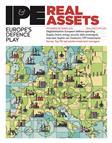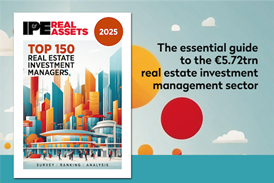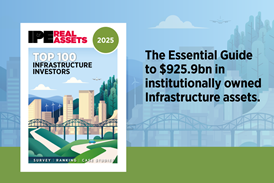REIT balance sheets are strong, boasting multi-decade low leverage and well-laddered debt maturities, writes Sonia Luton
After years in the shadows, real estate investment trusts (REITs) are poised for a revival.

Rising interest rates and the investor obsession with high-growth areas of the market, such as the Magnificent Seven, have long diverted attention from the REITs, leading to underwhelming returns for an extended period. But as economic policy in the US – the world’s largest economy – becomes increasingly erratic, the growth outlook is clouding. In this environment, investors may be ready to take a fresh look at the sector.
Crucially, the relative underperformance of REITs in recent years was not due to poor fundamentals or self-inflicted strategic errors. In fact, REIT operating conditions remain sound, with low vacancy rates, and speculative development remains largely uneconomic, courtesy of elevated construction costs and higher interest rates.
REIT fundamentals remain robust
REIT balance sheets are solid, with leverage at multi-decade lows and debt maturities well-laddered. Indeed, REIT capital structures are arguably stronger today than they were in any period entering an economic slowdown over the past 30 years.
Unloved and under-owned, REIT valuation multiples are relatively undemanding, and investor expectations are low. Based on our estimate, REITs are trading at or below replacement cost, which underpins values and rents.
Importantly, REIT earnings are not directly impacted by US tariffs. Real estate operating costs primarily include property taxes, repairs and maintenance, property management, and insurance. These costs, by and large, remain unaffected by tariffs. More directly, tariffs on building materials – such as steel, lumber, glass, and mechanical equipment – will likely further inflate already elevated construction costs. Tariff impacts could, in fact, benefit existing landlords by making development economics even more challenging, thereby deferring competitive new construction unless rents rise.
Of course, real estate will not be immune to the broader consequences if the current uncertainty leads to a slowing of economic growth or a recession. However, importantly, central banks have room to cut interest rates should there be clear evidence of a rapidly deteriorating economy without an outbreak of inflation. We see the biggest threat to our constructive thesis on REITs would be the onset of stagflation.
Diversification, transparency and liquidity
In many underlying real estate categories, REIT revenue (rental) streams are relatively secure, with medium to long-term lease contracts, often three to ten years in duration, which provide cashflow security, subject to tenant credit. Where these lease structures are common, industrial and office property are perhaps the most susceptible to a prolonged economic slowdown. This is why our portfolio is significantly underweight REITs in these sectors.
In other segments, such as residential, self-storage, and hotels, income is often derived from shorter-duration leases. In some of these instances, occupier demand is needs-based, and income tends to be relatively resilient. Hotels are the most economically sensitive, which is why we have minimal exposure to this sector.
While the policy environment surrounding tariffs and broader international relations remains unclear, we believe REITs are well-positioned to provide diversification, transparency, and liquidity in a world of increased uncertainty and volatility. Pleasingly, real estate is once again being viewed as a relatively secure sector of the equity market, generating meaningful distributions backed by recurring cash earnings.
However, in light of the increased broader uncertainty, we have recently reduced exposure to economically sensitive sectors, including industrial, office and hotels, and trimmed higher-multiple stocks such as data centres. In doing so, we reduced exposure to the US – a market that has delivered strong returns and has attracted a disproportionate share of global capital for an extended period. Additions were made to areas with valuation support and/or sound operating conditions – primarily diversified REITs in Japan and the UK, US residential and healthcare, and self-storage in the UK and Australia.
Undervalued UK offers real value
The UK is a market worth highlighting, as select UK REITs are among the cheapest listed real estate platforms within our universe. Even though investors initially had concerns about the policies of the Labour government, compared to what has since occurred in other regions, the initiatives appear positively benign. The UK economy continues to show growth, and the exchange rate remains steady. Furthermore, tenant demand remains positive, and there is evidence of available space shortages sustaining ongoing rental growth across several sectors, including offices.
While self-storage and student-housing appraisal valuations have remained stable, UK industrial, office and retail valuations have declined by over 25% from peak levels. Moreover, values have declined in an environment of increased replacement costs. The listed market is performing as if a major crash is imminent, with REIT prices trading at an average 25% discount to their underlying net tangible assets. This discount remains in effect even after income and property values have been materially reset lower following events such as Covid-19 and particularly weak retail leasing conditions in the UK post-Brexit.
The UK valuation dynamic is increasing the possibility of significant corporate activity, with several smaller take-private and merger deals announced so far this year, including takeover bids for NHS-backed healthcare REIT Assura and a number of externally managed warehouse REITs. Several significant real estate transactions have taken place, with a number of our holdings being on the sell side of the ledger, with transaction pricing at or above book values.
The pricing of these deals reflects investor confidence in the London property market and the UK economy as a whole. While many UK REITs boast bloated overheads, partly due to active development and partly due to their relatively small scale, most UK REITs have assets of less than £10bn (€11.7bn).
In a few cases, it also reflects a lack of confidence in management’s ability to protect, if not enhance, shareholder value over the long term. Therefore, boards and management should be compelled to find ways to narrow these discounts and create value for shareholders.
To read the latest IPE Real Assets magazine click here.


















